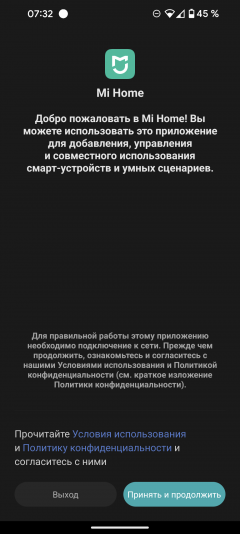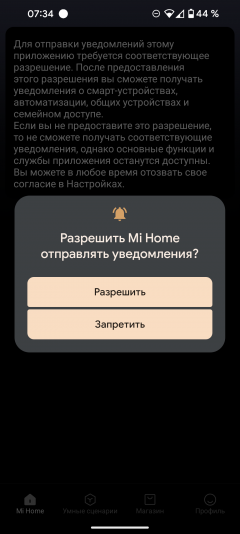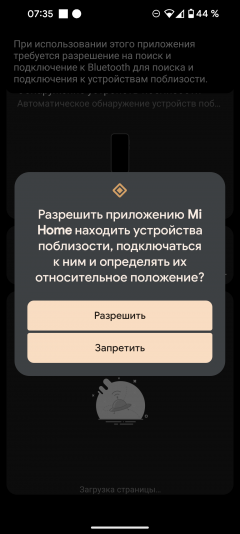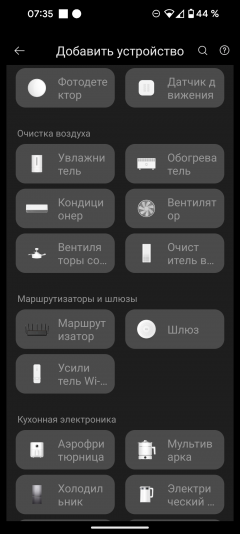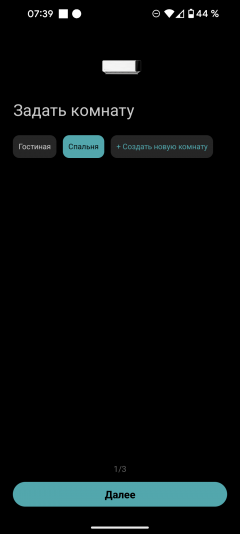Summer will come sooner or later, and with it — stuffy nights in the city. At such moments you often think: “Why haven’t I installed an air conditioner yet?” Therefore, it is worth preparing for the heat in advance.
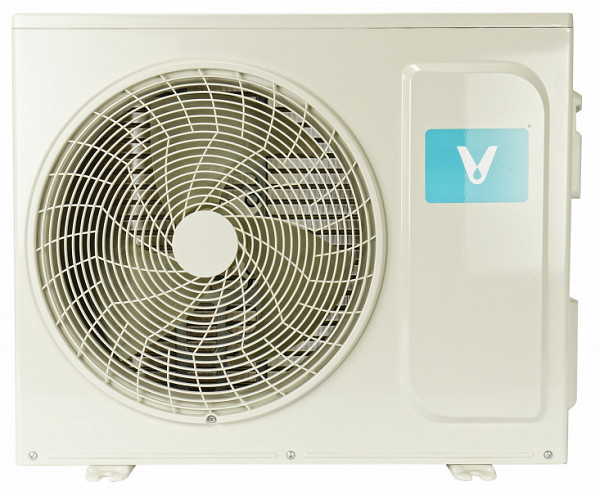
We tested the Viomi Cross 9K inverter air conditioner in different modes: from cooling to heating and ventilation.
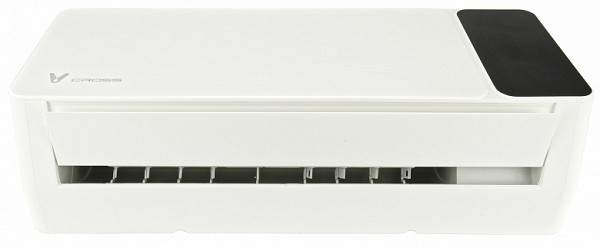
From the review you will find out how it cleans the air, whether it makes a lot of noise and whether it can be controlled from a smartphone. At the same time, we’ll tell you why the device is “inverter” and how this affects operation.
Characteristics
| Manufacturer | Viomi |
|---|---|
| Model | KFR-25GW/EY3PMB-A++/A+ |
| Type | inverter split system |
| Country of Origin | China |
| Guarantee | 3 years |
| Life time * | 6 years |
| Model features | Mi Home app control, UV sterilization, self-cleaning function, I Feel mode, 3D Airflow smart airflow |
| BTU | 9000 |
| Energy class | cooling: A++ heating: A+ |
| Cooling Energy Efficiency Ratio (SEER) | 6.1 |
| Heating efficiency coefficient (SCOP) | 4.0 |
| Power consumption (cooling) | 770 (250—1300) W |
| Power consumption (heating) | 690 (250—1300) W |
| Maximum current | 9.0 A |
| Power in cooling mode | 2500 W |
| Rated current during cooling | 3.5 A |
| Heating power | 2600 W |
| Rated current for heating | 3.1 A |
| Seasonal Energy Efficiency (SCOP) for Heating | 4.0 W |
| Drainage | 0.9 l/h |
| UV sterilization | 99.2% |
| Remote control | IR, Wi-Fi |
| Management app | Mi Home, Yandex Alice |
| Refrigerant | R32 |
| Indoor unit | |
| Noise level | 18—40 dB |
| Weight | 7 kg |
| Dimensions | 695×260×200 mm |
| Outdoor unit | |
| Noise level | 50 dB |
| Weight | 21.2 kg |
| Dimensions | 750×317×560 mm |
| Network cable length | 1.4 m |
* Contrary to popular belief, this is not the time limit after which the device will necessarily break down. However, after this period, the manufacturer ceases to bear any responsibility for its performance and has the right to refuse to repair it, even for a fee.
Equipment
The air conditioner arrived for testing in two boxes reinforced with nylon slings.
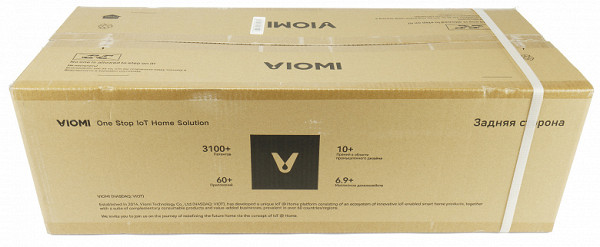
The first package contains the indoor unit, and the second contains the outdoor unit. The front sides of both boxes feature vector illustrations of the components along with the model number. The backs describe the company's accomplishments: thousands of registered patents, more than sixty applications, over ten industrial design awards, and nearly seven million installations.
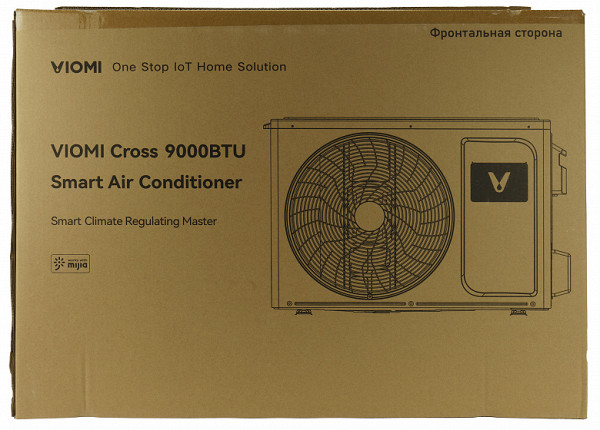
The split system kit includes:
- indoor unit
- outdoor unit
- remote control
- set of hardware for installation
- drainage tube with fitting
- user guide
- warranty card
- sticker with information about the energy efficiency of the device
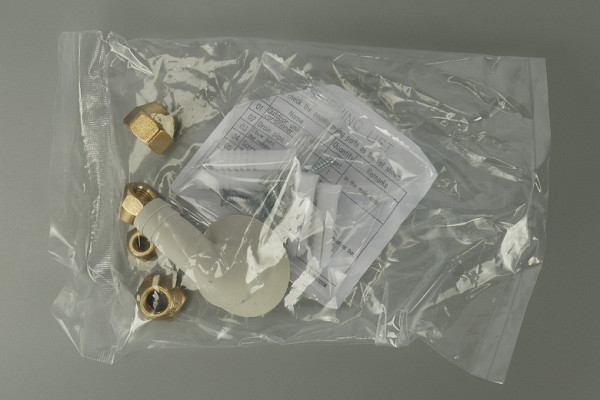
At first sight
The Viomi Cross line of split systems includes air conditioners of different capacities (9000, 12000 and 18000 BTU) in two colors — white and black. Today we're looking at a 9,000 BTU model with a white indoor unit. The split system consists of an indoor unit KFR-25G/EY3PMB-A++/A+ and an outdoor unit KFR-25W/YC8-A++/A+.
When operating a split system, the user sees the indoor unit more often than the outdoor unit—we’ll start with that.
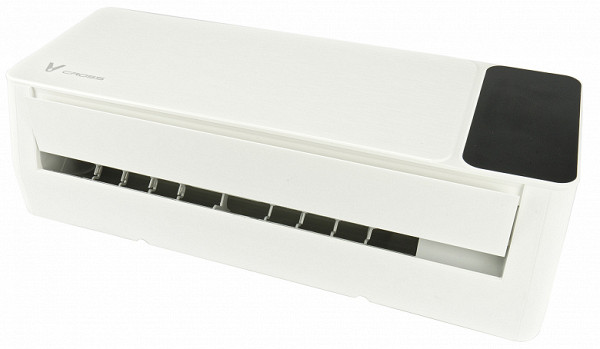
The internal block is shaped like a parallelepiped with smoothed corners. About a fifth of the front panel is occupied by a dark plastic display. Since the indication is not visible when the device is turned off, we will look at it in detail later, when we install and turn on the device.
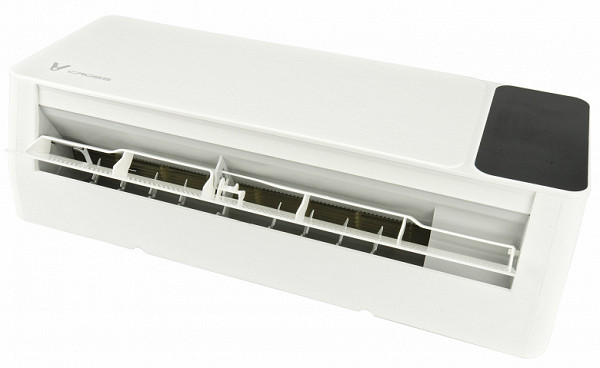
The curtain of the indoor unit has an internal surface with a relief consisting of five rows of small bulges. According to the manufacturer, this solution creates a golf ball effect, improving aerodynamics and making the airflow softer. Air flow adjustment in this model is possible in both vertical and horizontal directions.

The route connection to the indoor unit is provided on the right and left. It is also possible to lead inside the wall — for this, of course, the latter will have to be tapped.
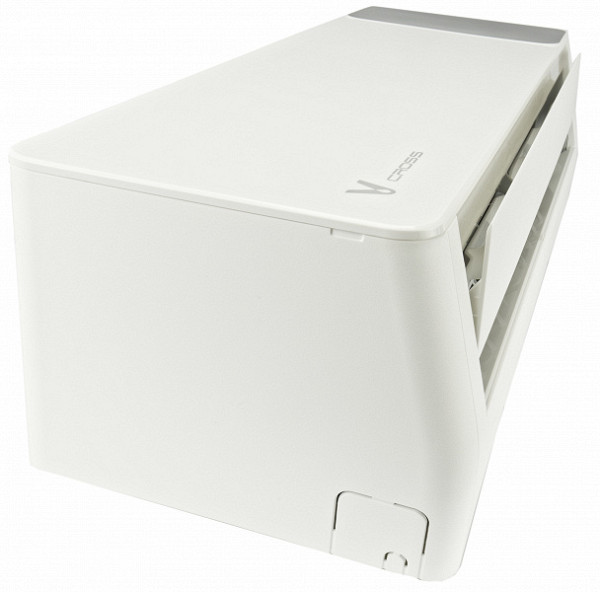
On the left side, the manufacturer has placed all the necessary information about the technical characteristics of the device, including the serial number and the QC sticker.

The front panel folds out completely and can be locked in the raised position — this is convenient for cleaning and servicing the device.
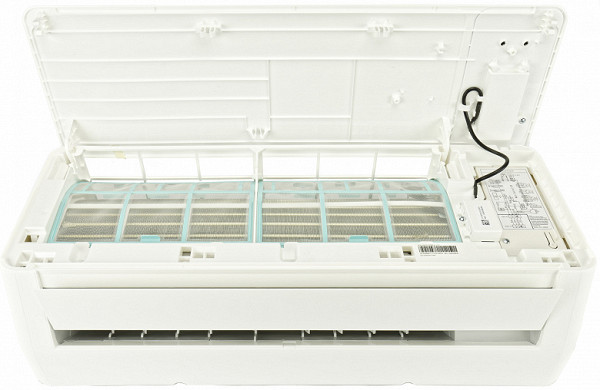
The display unit is mounted on a movable panel. It is connected to the control electronics by a flexible black wire. Under the screen you can see a sticker with a circuit diagram of the device.
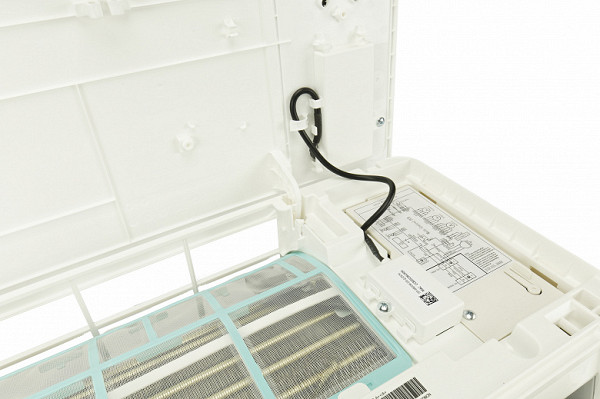
Most of the upper side is occupied by air intake openings covered with dust filters.

To remove the latter, you should open the front panel and pull out the mesh elements.
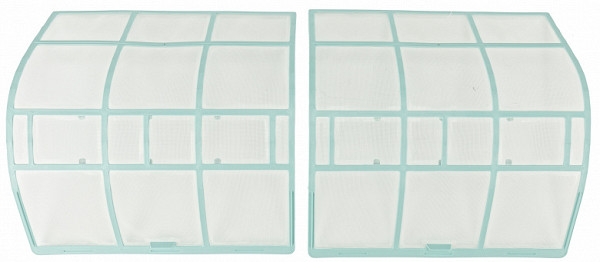
The design of the filters in our device is traditional: a fine nylon mesh is stretched over flexible blue frames. These elements are not afraid of moisture, so they can be washed when servicing the device.

Beneath the filters, yellow anodized heat exchanger tubes and fins are visible. Between the filter mesh and the grille there is a UV emitter in a plastic case.
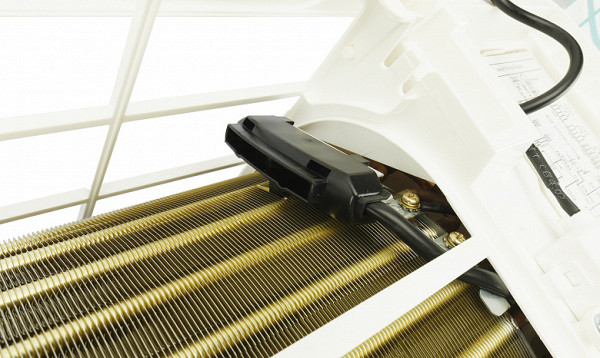
The U-shaped metal mounting frame ensures simple and quick installation of the device. The upper part of the frame fits into the grooves of the case, and the lower part is equipped with holes for latches that secure the internal unit.

Copper tubes for supply and return of refrigerant are enclosed in thermal insulating material. A white corrugated pipe is laid next to them to drain condensate. The 1.5 meter long electrical cable is equipped with a grounding Euro plug, so if there is an outlet near the installation site, you don’t have to worry about the connection.
Outdoor unit KFR-25W/YC8-A++/A+
The outdoor unit is white with a slight yellowish tint and decorated with the manufacturer’s logo without additional inscriptions. On the front side there is a traditional ventilation hole, covered with a plastic grille that matches the color of the case.
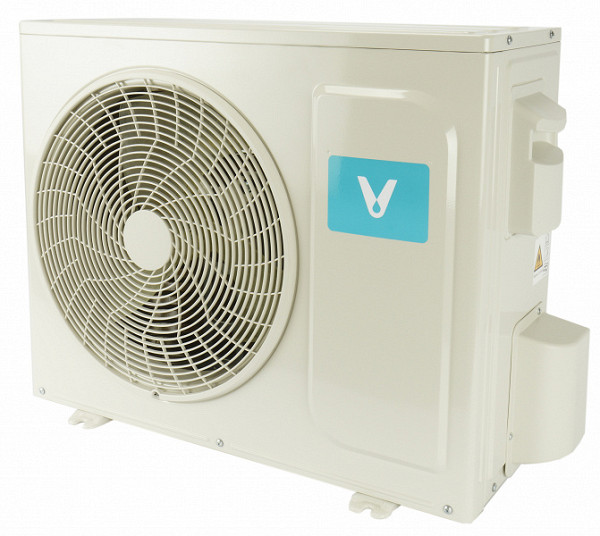
The L-shaped heat exchanger takes up most of the area on the left and rear edges. The air outlet holes are not covered with anything.

The tubes and fins of the heat exchanger are protected with a yellow anodized coating — the same as on the indoor unit.
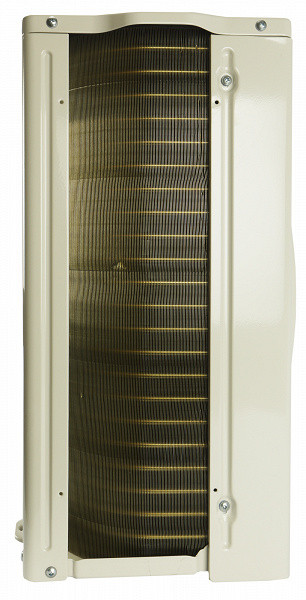
The connectors and fittings for connecting the route are located on the right side of the case and are covered with plastic covers.
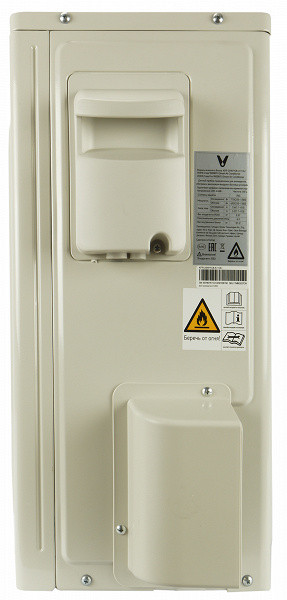
Having removed the lower casing, we see fittings for connecting the pipes through which the refrigerant will circulate.

Under the top cover there is a patch panel with four terminals.
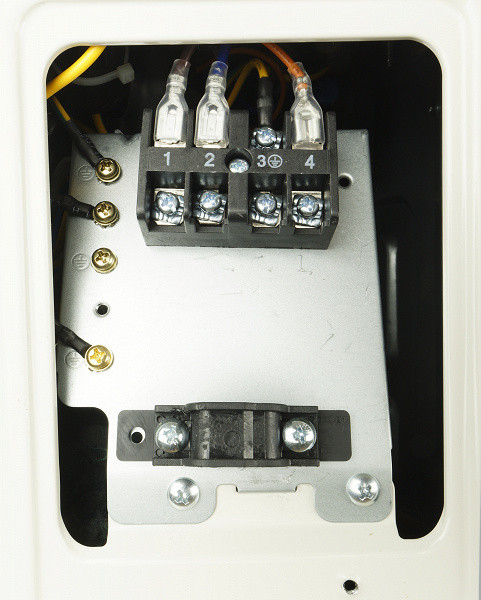
The silver sticker contains the technical characteristics of the device, information about the manufacturer and product certification. The serial number is on the adjacent label.
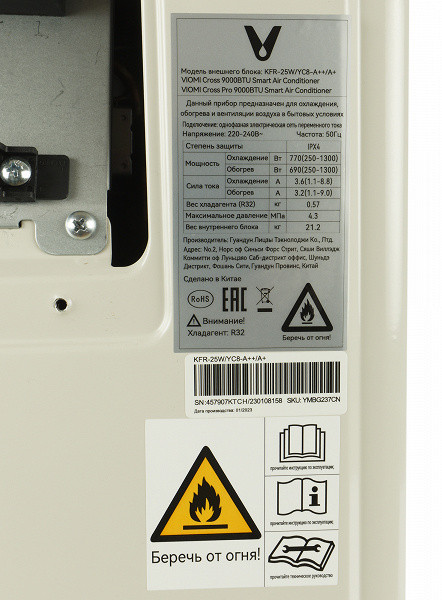
The control electronics and compressor can be accessed by unscrewing the four screws and removing the top cover.
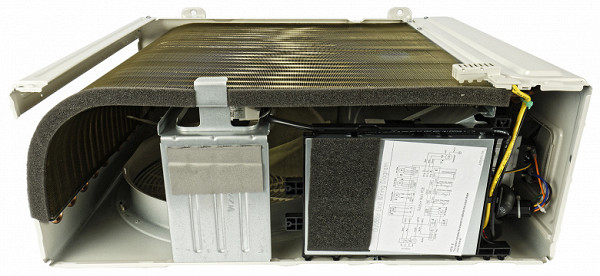
Underneath we see an electronic unit in a metal case, equipped with a sticker with a switching diagram.
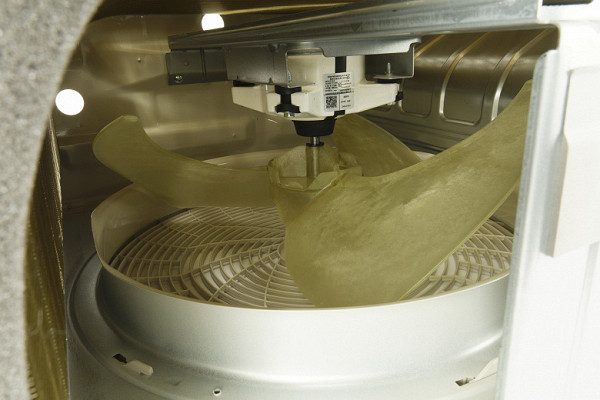
The three-bladed fan is made of yellowish translucent plastic.
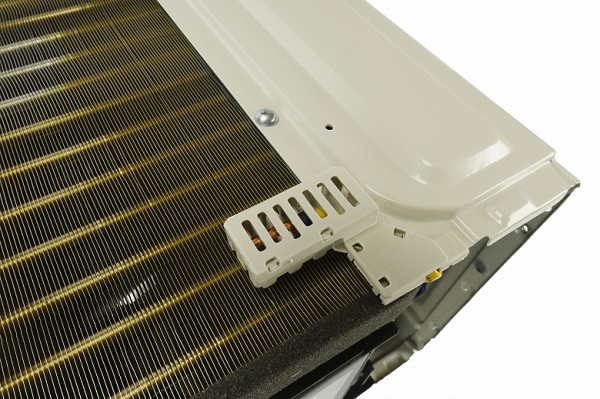
On the back side of the heat exchanger grille, a sealed temperature sensor is located in a separate plastic case with longitudinal holes.
Instructions
The user manual is a 40-page A5 brochure printed on thick glossy paper with excellent printing quality.
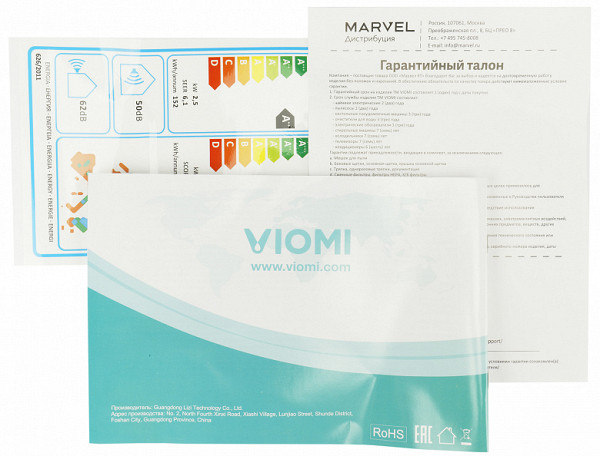
Often, manufacturers of large household appliances have instructions for several models of air conditioners, such as Cross and Cross Pro. The first eight pages discuss safety precautions for using the device. This is followed by a brief description of the general appearance of the device, display screens and remote control, connection to the mobile application and proper care of the device. The second half of the manual covers installation instructions in detail, including the correct placement of indoor and outdoor units, and installation of the air conditioner route. The instructions describe model-dependent functions and options without reference to specific devices, which requires the user to independently determine the features of the purchased device based on the documentation provided.
Control
The indoor unit does not have its own controls: configuration is carried out using a remote control or a mobile application. The digital display shows the current target air temperature.
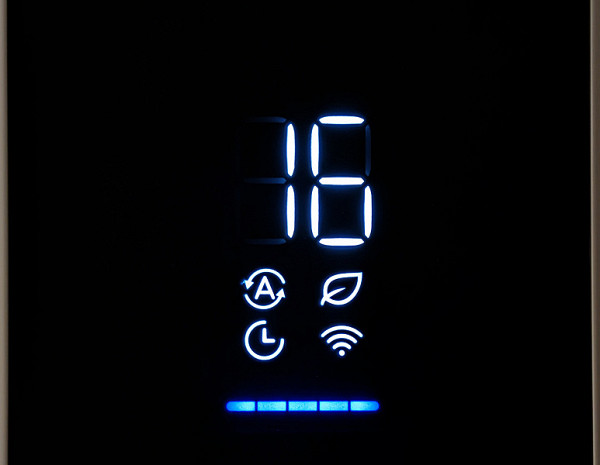
At the bottom of the display there is a colored bar that serves as an indicator of the current operating mode. Cooling is indicated in blue, heating in orange, and ventilation and dehumidification in purple.
The middle part of the display is complemented by four indicators. When the compressor is running, an «A» shaped symbol appears surrounded by arrows. The leaf icon lights up when the UV light is activated, the watch face symbol lights up when the timer is used, and the Wi-Fi logo lights up when the wireless connection is activated.
Remote control
The included infrared remote control provides ample opportunities for controlling the split system.

The control panel has a small liquid crystal display and many buttons. In the center of the square block there is a round “Mode” button, designed to select operating modes of the air conditioner: cooling, heating, dehumidification, ventilation or automatic mode.
The upper and lower segments of the ring button, indicated by the "+" and "−" symbols, are used to set the target room temperature or delay the auto shut-off timer.
The left and right segments of the ring button adjust the direction of air flow, controlling horizontal and vertical blinds. The first press activates the swing of the blinds, the second locks them in the selected position.
The «Turbo» button turns on the maximum power mode, which is useful for quickly cooling or heating a room.
The “Speed” button controls the rotation speed of the indoor unit fan. The device offers three fixed fan speeds. A fourth press puts the fan into auto mode, where it adjusts automatically based on the difference between the current and target temperatures.
The “I Feel” function, activated by a separate button, allows the air conditioner to take into account the temperature at a selected point in the room, using the thermometer built into the remote control instead of the built-in indoor unit. This is especially useful for adjusting the climate in certain areas of the room, such as a work area or sleeping area.
The “Display” button controls the display on the indoor unit, allowing you to turn the display on and off.

The following buttons are located above the central block:
- “Power”: used to turn on the device or put it into standby mode.
- “UVC”: turns on and off the ultraviolet lamp built into the indoor unit, which helps effectively fight pathogens.
- “Eco”: controls the energy saving mode; When activated, the device uses an operating algorithm with minimal power consumption.
The following additional functions depend on the bottom row of buttons:
- “Clean”: starts the device’s self-cleaning mode.
- “Timer”: allows you to set the auto shutdown time; Using the “+” and “−” buttons, you can set the system’s automatic shutdown timer in the range from 1 to 24 hours in 1-hour increments.
- “Quiet”: turns confirmation sounds on and off.
- “Sleep”: activates the night mode, in which the device’s display turns off and the fan goes to minimum power.
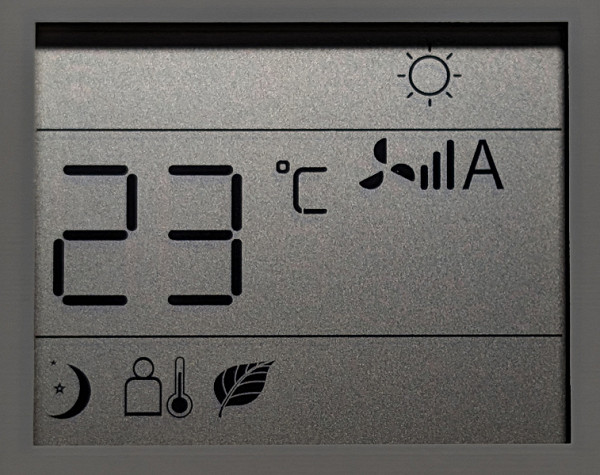
The top of the LCD display shows the currently selected operating mode: icons for cooling, dehumidifying, ventilation, heating or automatic program may be visible. There is also a Wi-Fi connection status indicator here.
The central part of the display is occupied by large numbers displaying the target temperature set by the user. Next to the numbers are indicators of the fan rotation speed, the position of the vertical and horizontal blinds, as well as the activation of the auto-shut-off timer.
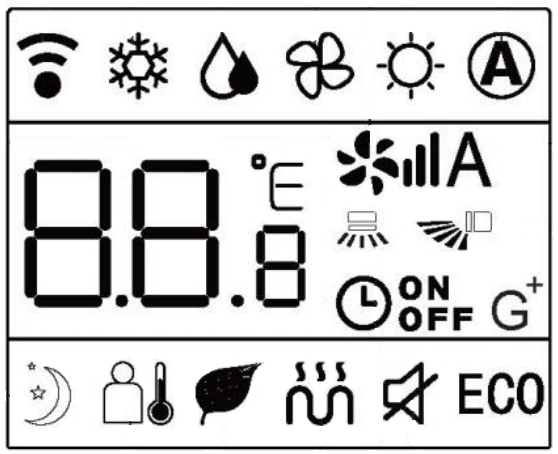
The bottom row contains indicators for night mode, I Feel function, UV light, mute and Eco mode. The fourth character from the left is not used in our model.
Smartphone control
For even more flexible control of the split system, the manufacturer offers the Mi Home application (Beijing Xiaomi Mobile Software Company)

The popular Xiaomi app has over 50 million downloads and is rated 4.5 out of 5 based on over 1.23 million reviews.
To start using the device, you must accept the terms of use and agree to the privacy policy. You are also required to register by confirming your email address or mobile phone number.
The program needs access to device location data and the ability to find devices nearby. It is also advisable to provide access to sending notifications.
To add a split system, you need to open the application and use the “+” icon located in the upper right corner of the main screen. Then select the device type — “air conditioner”. The application will provide detailed and clear instructions for activating pairing mode: you must quickly press the “Display” button on the remote control six times within seven seconds until the device beeps and the “Wi-Fi” indicator begins to flash.
After this, the application requests data to access the wireless network (only 2.4 GHz frequency is supported) and transfers the settings to the split system. The procedure takes no more than a minute and is completed without any difficulties.
After this, all that remains is to give the air conditioner a clear name and link the device to the selected room in the smart home.

The main screen of the application displays information about the target temperature and the current operating mode of the air conditioner. At the bottom of the screen there are buttons for switching the device to cooling, heating, drying, ventilation and auto mode, as well as for controlling the timer and backlight. Additionally, you can activate the night mode, adjust the fan power and the direction of air flow in the horizontal and vertical planes.
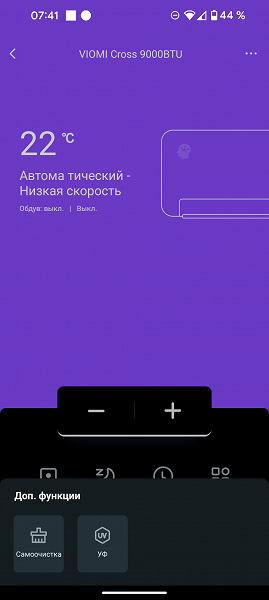
Button «Additional» functions" provides access to icons for the self-cleaning and UV treatment functions.

On the Settings page, you can change the name of the device, move it to another room in the house, share control rights with family members, view help materials, and check that the firmware is up to date.
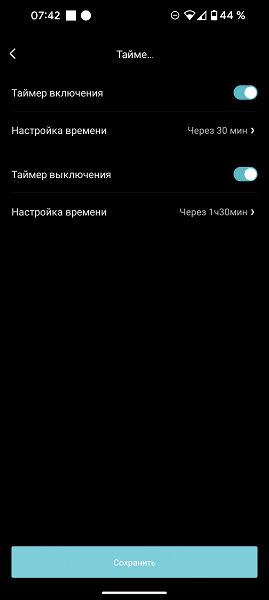
The application allows you to set up two timers: here you can set a delay for turning on and off the device.
Exploitation
During operation, the split system did not present us with any particular surprises: it is easy to control and works predictably.

The damper of the indoor unit allows you to direct the air flow within approximately 90°: it can be oriented horizontally, parallel to the ceiling, or downwards along the wall. You can also adjust the direction of air flow in the horizontal plane by the same 90°.
The operation of the indoor and outdoor units does not create significant noise, which allows even people with restless sleep to sleep peacefully. In a later study, we will measure the sound pressure generated by the indoor and outdoor units.
In dehumidification mode, the device dries the air in the room, while slightly reducing the temperature. This model does not have a built-in hygrometer, so it is impossible to set and maintain a set air humidity value.
The ventilation mode does not provide either cooling or heating: the indoor unit only mixes the air in the room, providing circulation. Like many other split systems, this model is not capable of supplying fresh air from outside. The user must ensure the ventilation of the room independently.
A special feature of this model is the self-cleaning mode: when activated, the air conditioner first operates at maximum cooling, and then at maximum heating after a few tens of minutes. Excess moisture generated in the first stage washes away contaminants from the evaporator, and the high temperature helps dry the heat exchanger, which helps eliminate bacteria and unpleasant odors.
During automatic cleaning, “AC” flashes on the indoor unit display. The process takes about 50 minutes, after which the device beeps and goes into standby mode.
When there is a short power failure, the air conditioner turns off and goes into standby mode. The next time you turn it on from the remote control, it resumes operation in the last selected mode with all settings saved.
Care
Before you begin servicing the air conditioner, you must turn it off and disconnect it from the power supply.
The front panel of the indoor unit should be wiped with a soft cloth soaked in warm water (no more than 40°C). The use of organic solvents and solid objects is strictly prohibited.
When cleaning the remote control, only use a dry cloth; humidity is welcome.
The manufacturer recommends cleaning the air filters of the indoor unit at least once every two weeks, otherwise this may negatively affect the performance and efficiency of the device.
You can use a vacuum cleaner to clean the filters. They can also be washed in water and mild soap or detergent. After washing, the filters should be allowed to dry naturally.
During temporary breaks in operation, it is recommended to leave the indoor unit turned on with the blinds running for 3-4 hours to dry completely. After this, you need to clean the air filter meshes, turn off the device and the control panel.
Our measurements
Unlike traditional on/off split systems, Viomi Cross 9000 uses an inverter compressor that smoothly regulates power depending on the difference between the set and current room temperature.
To illustrate the operation of the device, two temperature sensors were installed: one at the input, the other at the output of the indoor unit. We ran the air conditioner in cooling mode, setting the target temperature at 18°C. At the same time, we recorded the power consumption of the device.
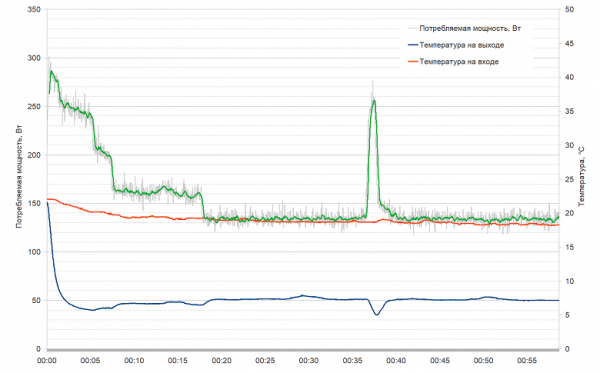
After switching on, the air conditioner operated at maximum cooling power for some time, reaching a peak consumption of up to 270 W. As the room temperature dropped, it smoothly adjusted the power and stabilized at about 137 watts. In this mode, it continued to work, from time to time increasing power consumption to the maximum value.

The power used, of course, depends on the area of the room and the intensity of air exchange in it. With the windows and doors open, the air conditioner can operate at full power for a long time, but the air temperature continues to drop.
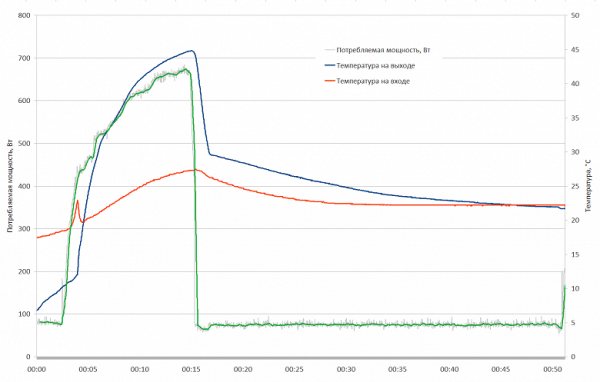
The air conditioner works similarly in heating mode, but the energy consumption schedule is different here: the device smoothly increases power until the temperature reaches the set value, and then turns off the compressor, switching to ventilation mode. When the temperature at the device inlet drops below the set value, the air conditioner will turn on the compressor again.
The maximum power consumption of the device depends on the selected operating mode.
| Mode | Maximum power, W |
|---|---|
| Ventilation | 28 |
| Drainage | 137 |
| Cooling | 255 |
| Heating | 672 |
Daily energy consumption depends largely on the selected operating mode, as well as the volume of the room, indoor and outdoor temperatures, and the user-set target temperature.
Turning on the UV emitter increases power consumption by approximately 5 W. In standby mode, the split system consumes about 5.5 W.
The sound pressure level was measured using a sound level meter at a distance of 1 m from the operating device, pointing the microphone towards the sound source. The noise of the external unit in maximum power mode is about 45 dBA.
The sound from the indoor unit depends on the selected fan operating mode.
| Flow power | I | II | III |
|---|---|---|---|
| Noise, dBA | 39 | 42 | 48 |
To roughly estimate the maximum air flow rate, we measured the flow rate by placing an anemometer close to the indoor unit outlet grille at 13 points. The average speed was approximately 3.70 m/s. With a known cross-sectional area of the air duct (590×55 mm=0.032 m²), the productivity can be calculated: 7.1 m³/min, or 426 m³/hour.
conclusions
The Viomi Cross 9000 split system is equipped with an inverter compressor, which provides high efficiency and does not create a significant load on the electrical network. An effective control system complements the design well: the energy consumption of this model is minimal in both cooling and heating modes.
This air conditioner is suitable for small and medium-sized rooms. For larger apartments and offices, the manufacturer offers more powerful models with 12,000 and 18,000 BTU. The Viomi split system is available in two colors: classic white and stylish black.

Thanks to the built-in ultraviolet lamp in the indoor unit, the air conditioner not only provides a comfortable temperature, but also effectively destroys pathogens. The self-cleaning system prevents the growth of bacteria on the evaporator grille, promoting a healthy microclimate.
A special feature and ease of use is the “I Feel” mode, which allows the air conditioner to measure the temperature not in the indoor unit, but where the control panel is located. This allows you to more accurately regulate the climate in work or sleeping areas.
To control your smartphone, the manufacturer provides a convenient and functional mobile application. During practical tests, we also made sure that the Viomi Cross air conditioner is compatible with the Yandex voice assistant: Alice allows you to control the device, receive information about its status and schedule automatic switching on or off.
We consider the only drawback of the device to be the impossibility of integration into autonomous smart home systems: remote control is available only through Xiaomi cloud services.
Pros:
- excellent efficiency
- convenient control
- UV and self-cleaning functions
- low price
Minuses:
- impossibility of integration into autonomous smart home systems


